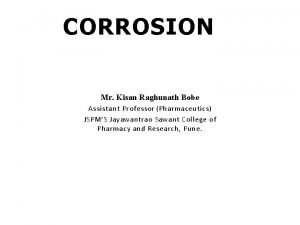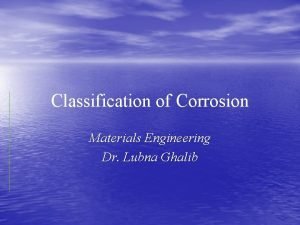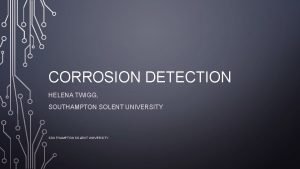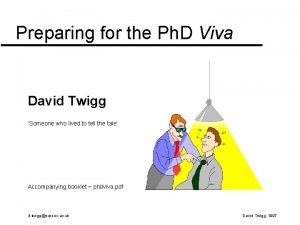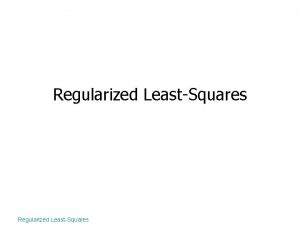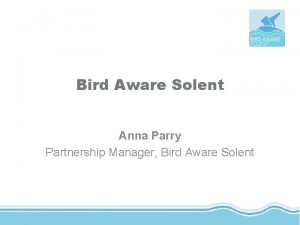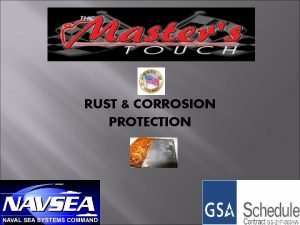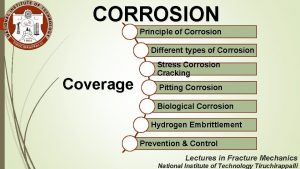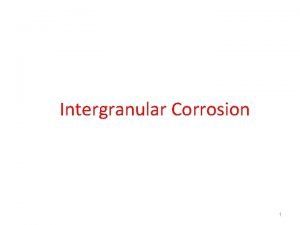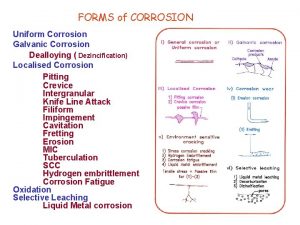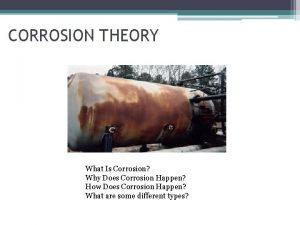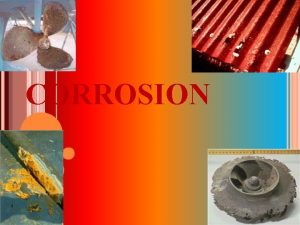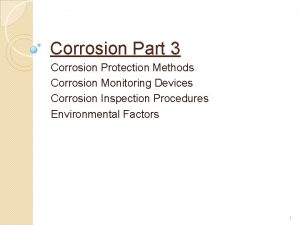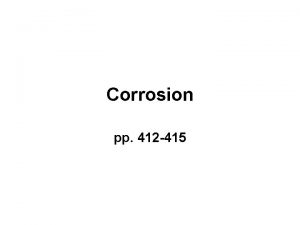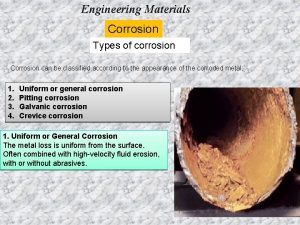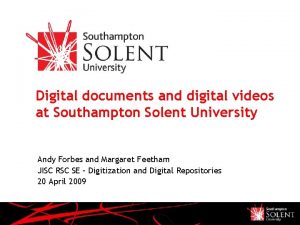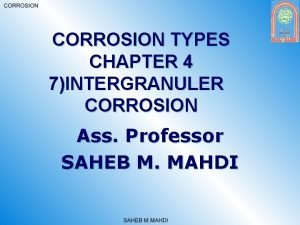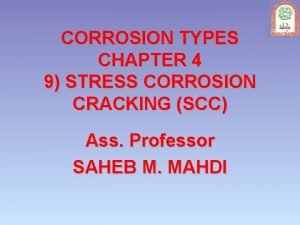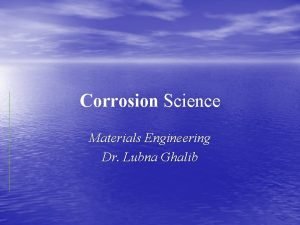CORROSION DETECTION HELENA TWIGG SOUTHAMPTON SOLENT UNIVERSITY WHAT



















- Slides: 19

CORROSION DETECTION HELENA TWIGG, SOUTHAMPTON SOLENT UNIVERSITY

WHAT IS CORROSION? Surface corrosion – ugly but not yet structurally dangerous http: //www. european-coatings. com/var/ezflow_site/storage/images/european-coatings/home/raw-materialstechnologies/applications/protective-marine/corrosion-behaviour-analysed/504626 -1 -eng-GB/Corrosion-behaviour-analysed. jpg SOUTHAMPTON SOLENT UNIVERSITY

WHAT IS CORROSION? Surface corrosion – ugly but not yet structurally dangerous More serious corrosion – function is impaire http: //www. daviddarling. info/images/pipeline_corrosion. jpg SOUTHAMPTON SOLENT UNIVERSITY

WHAT IS CORROSION? More serious corrosion – function is impaire Corrosion can occur in one place http: //www. monkeywrenchps. co. uk/wp-content/uploads/2012/08/Corrosion_Steel 1. jpeg SOUTHAMPTON SOLENT UNIVERSITY

WHAT IS CORROSION? Corrosion can occur in one place Corrosion can occur catastrophically SOUTHAMPTON SOLENT UNIVERSITY

EXISTING CORROSION DETECTION METHODS • Forth Road Bridge near Edinburgh used microphones to sense when corroded steel cables snapped – this led to the decision to create the Queensferry crossing • Florida authorities are using SAW technology to monitor corrosion in steel reinforced concrete bridges • Ultrasonics and acoustics are used extensively but require embedding or acoustic impedance matching SOUTHAMPTON SOLENT UNIVERSITY

PROJECT SCOPE • Decided to limit to steel corrosion (rust) • Decided to investigate corrosion sensing electronically • How is rust different to metal? SOUTHAMPTON SOLENT UNIVERSITY

HOW IS RUST DIFFERENT TO METAL? • No longer rigid • No longer crystalline • Visually different • Rough • Flaky • Non-conductive SOUTHAMPTON SOLENT UNIVERSITY

NON-CONDUCTIVE • When a layer of rust is present, with steel underneath, a metallic sensor in contact with the rust would make an electric capacitor SOUTHAMPTON SOLENT UNIVERSITY

SENSING RUST SOUTHAMPTON SOLENT UNIVERSITY

CIRCUIT TO DETECT CHANGE IN CAPACITANCE • 555 timer circuit • Gives a signal out that changes frequency based on chosen capacitor value • Would give different signal if rust were present or absent SOUTHAMPTON SOLENT UNIVERSITY

555 TIMER CIRCUIT OUTPUT SOUTHAMPTON SOLENT UNIVERSITY

DIFFERENT SENSORS • Tried different sensor ideas, both with and without their own layer of dielectric. SOUTHAMPTON SOLENT UNIVERSITY

PROBLEMS! • If the sensor had its own dielectric, there was no difference in output signal observed when the sensor was placed on rust vs. a rust-free surface • The signal varied widely due to pressure on the sensor, and this variation was much greater than the natural variation due to noise • The sensor wire connecting back to the circuit appeared to be acting as an antenna and picking up RF noise present in the laboratory SOUTHAMPTON SOLENT UNIVERSITY

FINAL SENSOR DESIGN • No dielectric! • Neodymium magnets • Shielded coaxial cable SOUTHAMPTON SOLENT UNIVERSITY

SOUTHAMPTON SOLENT UNIVERSITY TESTING DIFFERENT RUST THICKNESSES

RESULTS Frequency obtained from corrosion sensor on areas 1, 2 and 3 8. 5 Frequency (k. Hz) 8 7. 5 7 6. 5 6 5. 5 Area 1 SOUTHAMPTON SOLENT UNIVERSITY Area 2 Area 3

RESULTS Frequency obtained from corrosion sensor on areas 1, 2 and 3 9 8. 5 Frequency (k. Hz) 8 7. 5 7 6. 5 6 5. 5 5 4 0 1 2 3 4 5 Day number SOUTHAMPTON SOLENT UNIVERSITY Area 1 Area 2 Area 3 6 7 8 9

RESULTS • Different areas of the brake disc gave different frequencies • These changed over time • More work required! • Determine whether thickness of rust is a factor in output frequency • Sensor system detects corrosion in some forms SOUTHAMPTON SOLENT UNIVERSITY
 Differentiate between dry corrosion and wet corrosion
Differentiate between dry corrosion and wet corrosion Differentiate between wet and dry corrosion
Differentiate between wet and dry corrosion Solent university
Solent university David twigg
David twigg Twigg
Twigg Makayla bradley
Makayla bradley Southampton enabling services
Southampton enabling services Stoneham centre physiotherapy
Stoneham centre physiotherapy Powerboat level 2 solent
Powerboat level 2 solent Solent green
Solent green Bird aware solent
Bird aware solent Pgr tracker soton
Pgr tracker soton Eprints soton
Eprints soton Southampton city council homeless
Southampton city council homeless Southampton township school district
Southampton township school district Population of southampton 2021
Population of southampton 2021 Southampton county, virginia plantations
Southampton county, virginia plantations Sussed southampton login
Sussed southampton login New vevox app
New vevox app Southampton district energy scheme
Southampton district energy scheme
